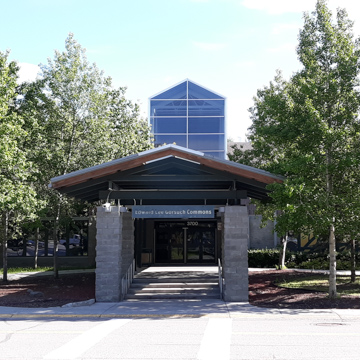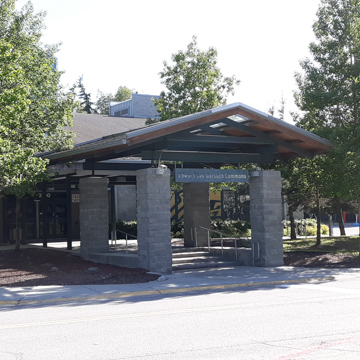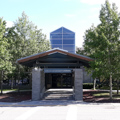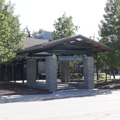You are here
Lee Gorsuch Commons
Completed in 1998, the Residential Living Commons (as it was initially known) at the University of Alaska Anchorage (UAA) has served as the hub of the on-campus living community for over twenty years. Longtime UAA Chancellor Lee Gorsuch (1994-2004) believed that the construction of dormitories “will reverse Alaska’s brain drain” and entice a new generation of college students to stay in the state to complete their education. The Commons entrance provides the feel of a modest mountain lodge with a vaulted foyer. The exterior is constructed of concrete blocks, brick, and corrugated steel. The green trim and exposed glass that allow natural light to flow in from above are conversant with other buildings on campus built around in the late 1990s and early 2000s, namely the Conoco-Phillips Integrated Science Building and the renovations to the Engineering Building and UAA/APU Consortium Library. The Commons is one of several of UAA’s main dining options, including the Creekside Eatery cafeteria and dining area, as well as a convenience store known as the Bear Necessities Grill. The Commons is conveniently located immediately south of much of the campus. A shuttle runs regularly to transport students from the residence hall to various campus locations.
Upon entering the building, on-campus residents have access to UAA’s housing front desk, conference services, and the mailroom. The Gorsuch Commons is designed to invite community activities, from game nights to invited lectures and public talks. Many residents gather near the community fire pit in the front lobby, the Cama-i room, which is open to all UAA students, as well as in the dining halls and conference rooms. The Cama-i-room is outfitted with couches, chairs, and tables to encourage congregation and a sense of community. The Commons is active throughout the day, since UAA’s meal plan is mandatory for those living on campus.
Beginning in the early 1990s, UAA administrators, led by Gorsuch, lobbied the Alaska Legislature to fund the new residence halls and expand UAA in the mold of a more traditional residential campus. The Legislature appropriated a total of $800,000 and approved a $33 million loan from the Alaska Housing Finance Corporation, a nonprofit housing agency, to complete the construction. The quest for funding was long and drawn out, mostly as a result of the appropriation failing in the legislature for several sessions. A contingent of legislators from Fairbanks (the home of the University of Alaska Fairbanks) feared that the University of Alaska Anchorage would compete for students who chose to remain in Alaska for college and live on campus.
Between the newly built dorms and community housing around campus, roughly 1,000 or 1 in 17 students lived on campus as of 2017. The Commons now bears Lee Gorsuch’s name for his tireless commitment to building a residential community at the University of Alaska Anchorage.
References
Mike Doogan, "New On-Campus Housing Brings High Hopes for UAA Student Life," Anchorage Daily News, September 4, 1998, B1.
Jamie Gonzales. “Cama-i Room Program Highlights for Dec. 12-16, 2011.” University of Alaska Anchorage, December 9, 2011. https://www.uaa.alaska.edu/.
Elizabeth Manning, “UAA Adds Homey Feeling - Officials Hope Dorms Foster Campus Life,” Anchorage Daily News, August 28, 1998, C1.
Writing Credits
If SAH Archipedia has been useful to you, please consider supporting it.
SAH Archipedia tells the story of the United States through its buildings, landscapes, and cities. This freely available resource empowers the public with authoritative knowledge that deepens their understanding and appreciation of the built environment. But the Society of Architectural Historians, which created SAH Archipedia with University of Virginia Press, needs your support to maintain the high-caliber research, writing, photography, cartography, editing, design, and programming that make SAH Archipedia a trusted online resource available to all who value the history of place, heritage tourism, and learning.

















